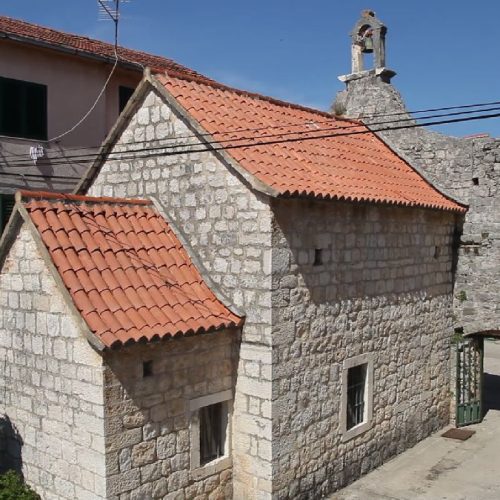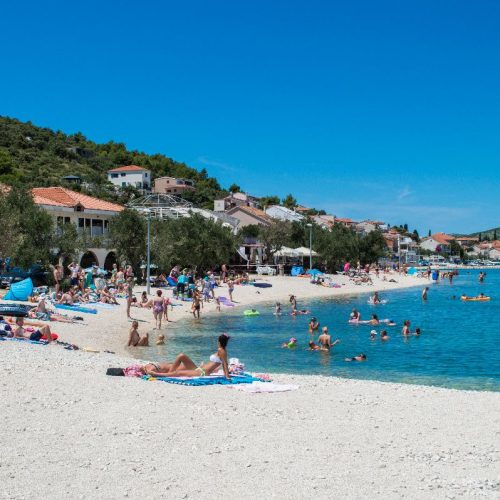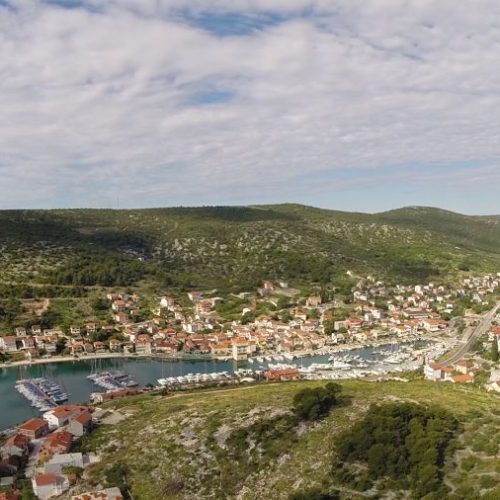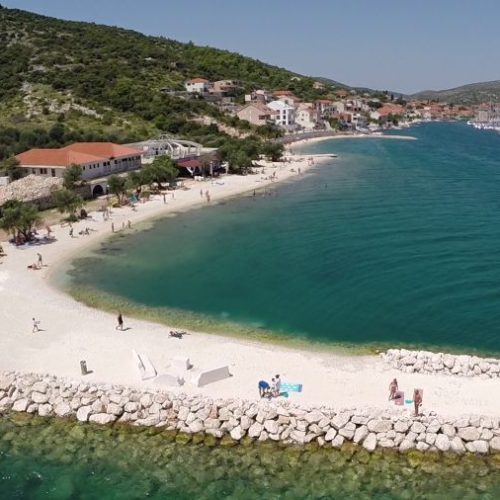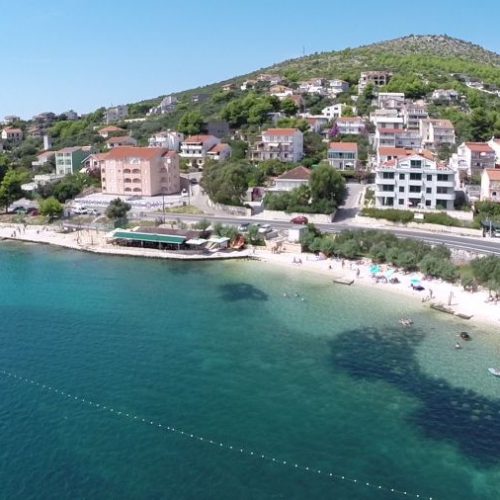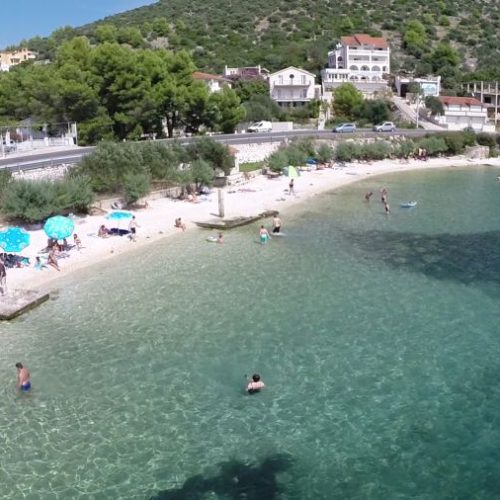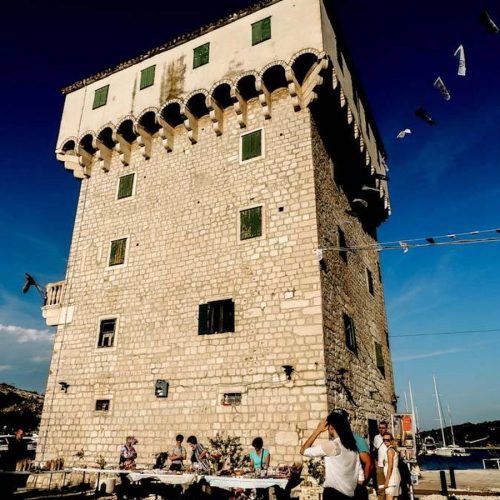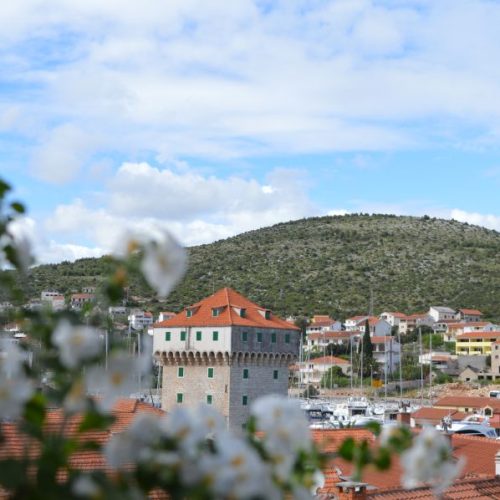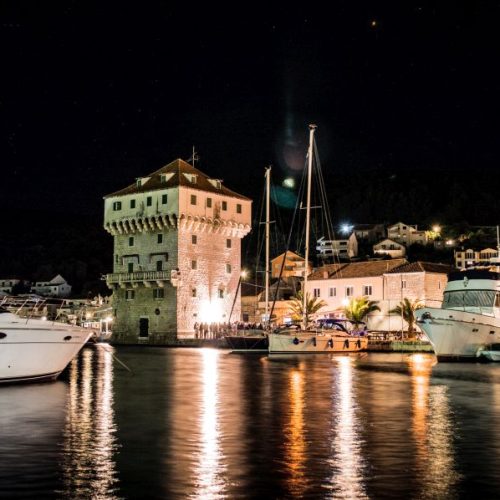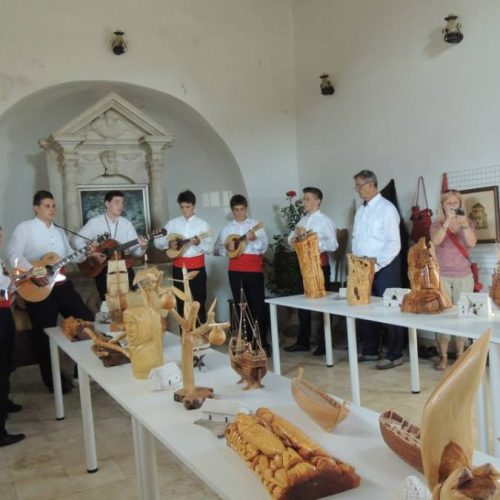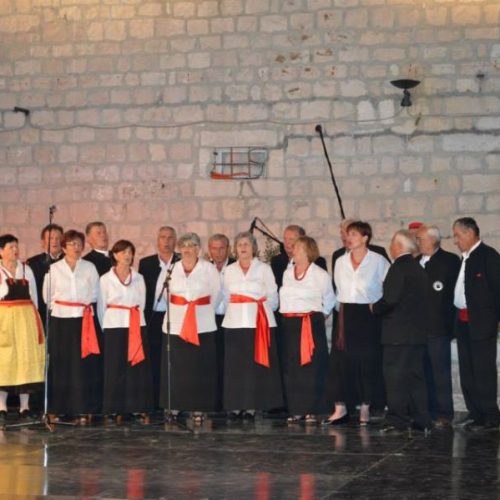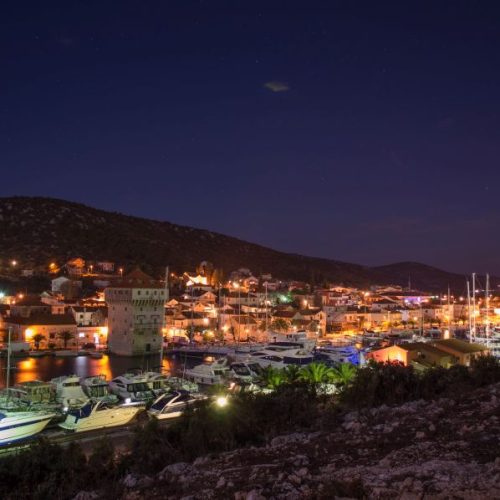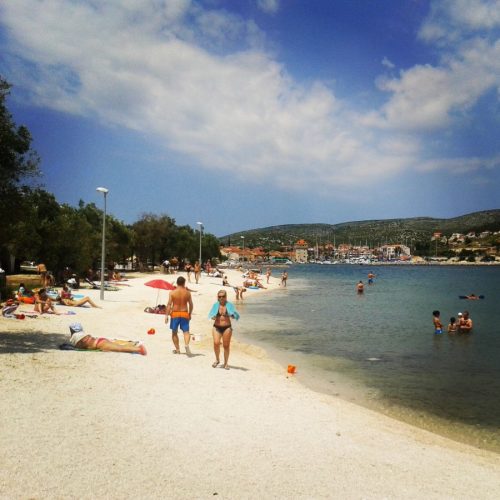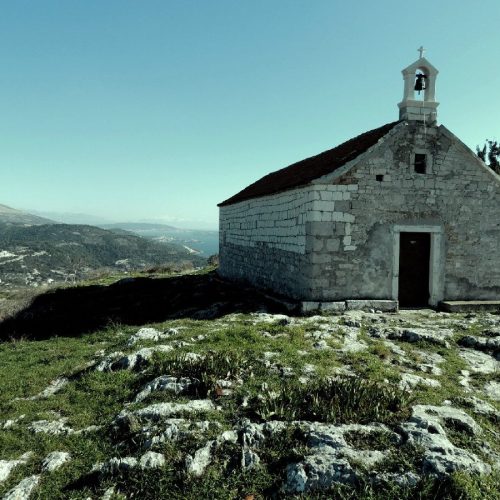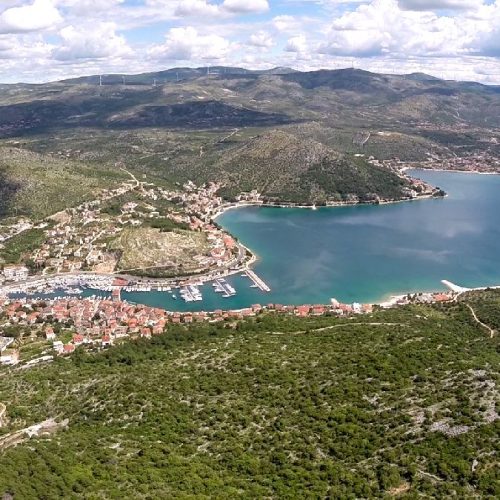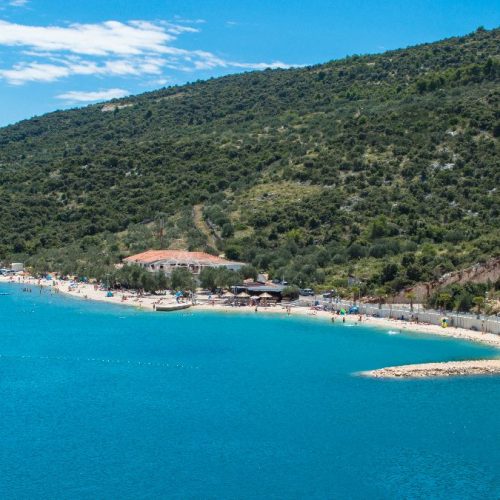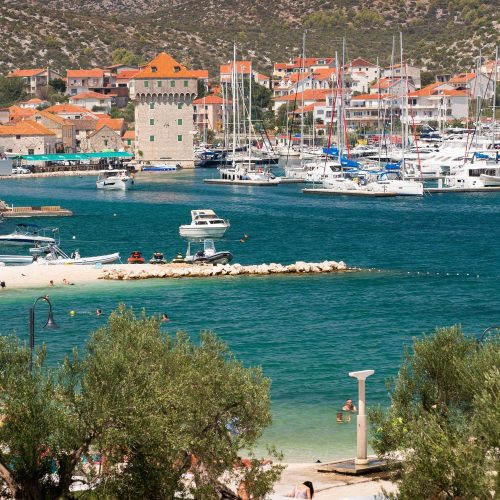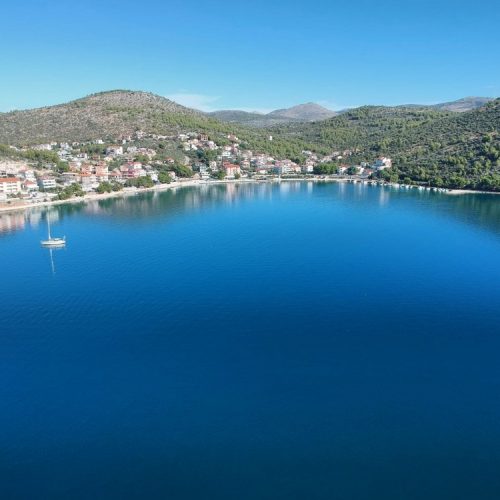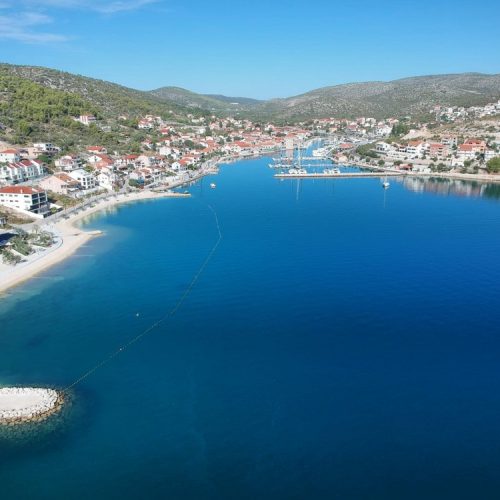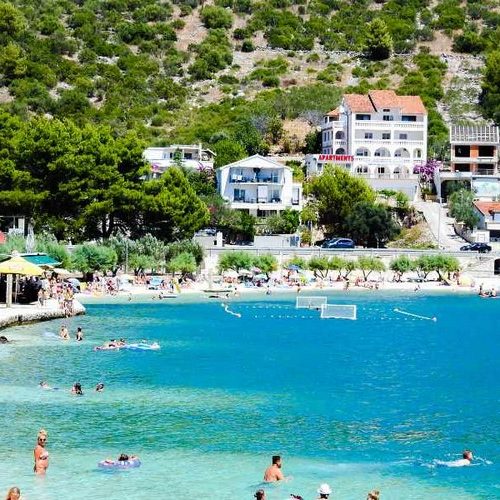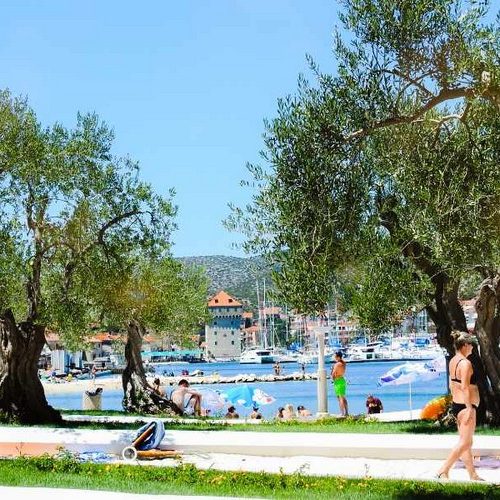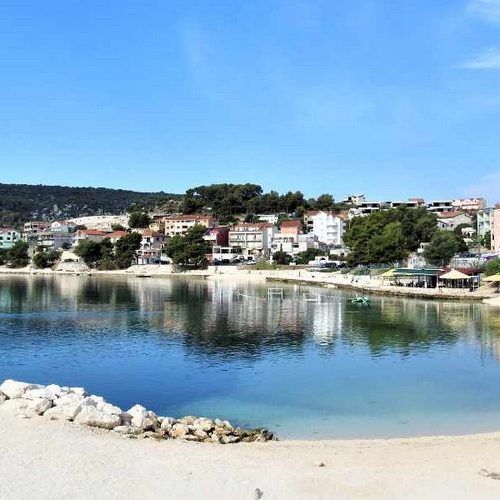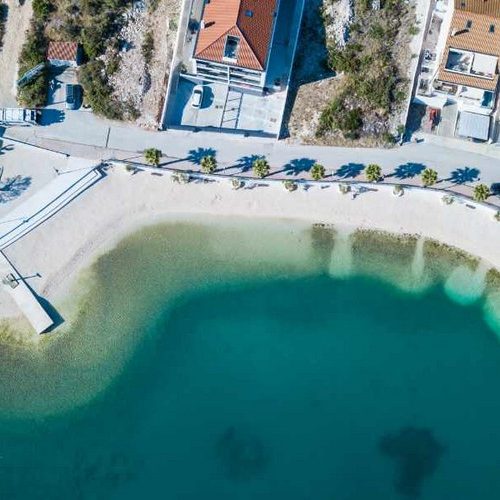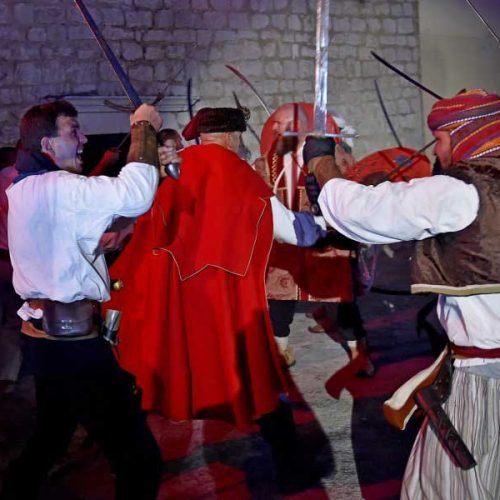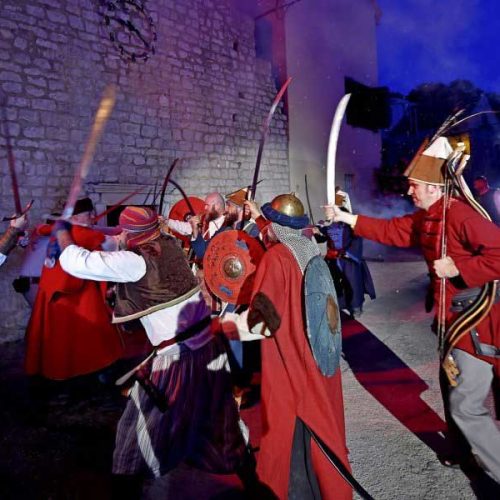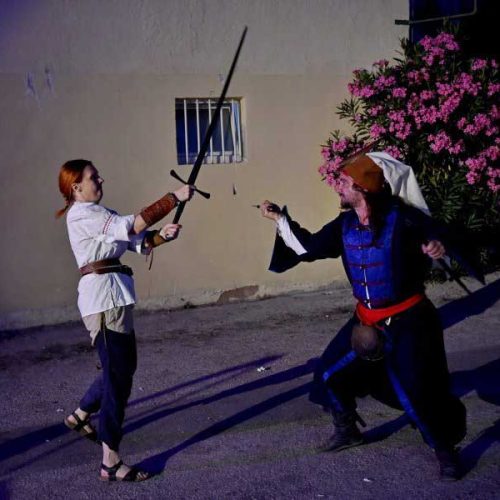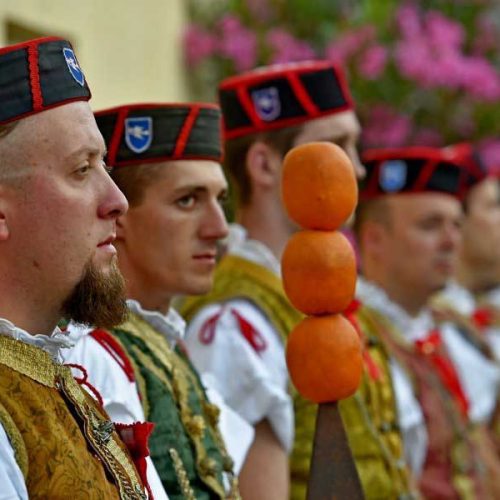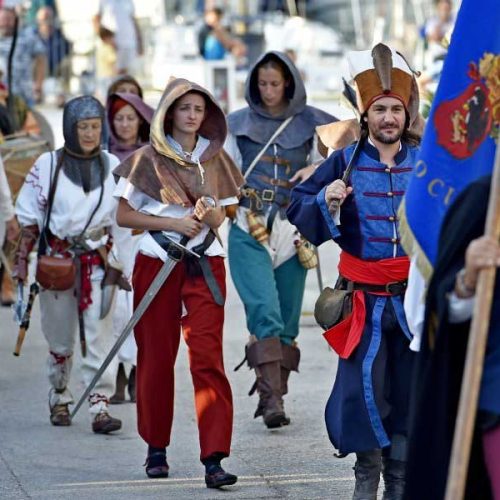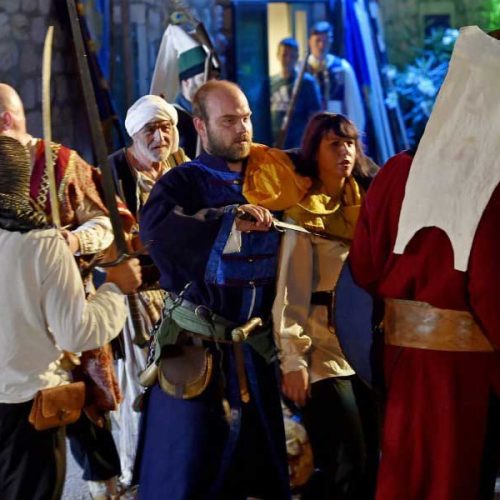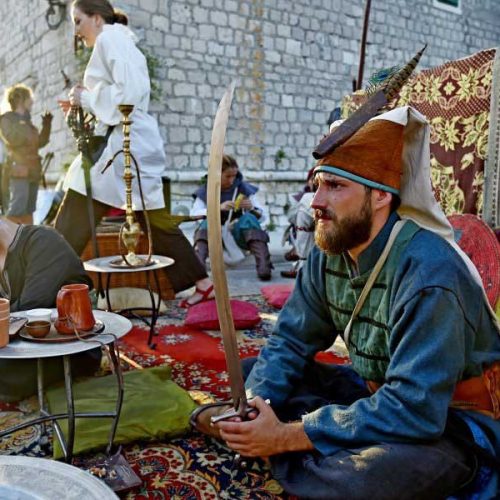MARINA
-
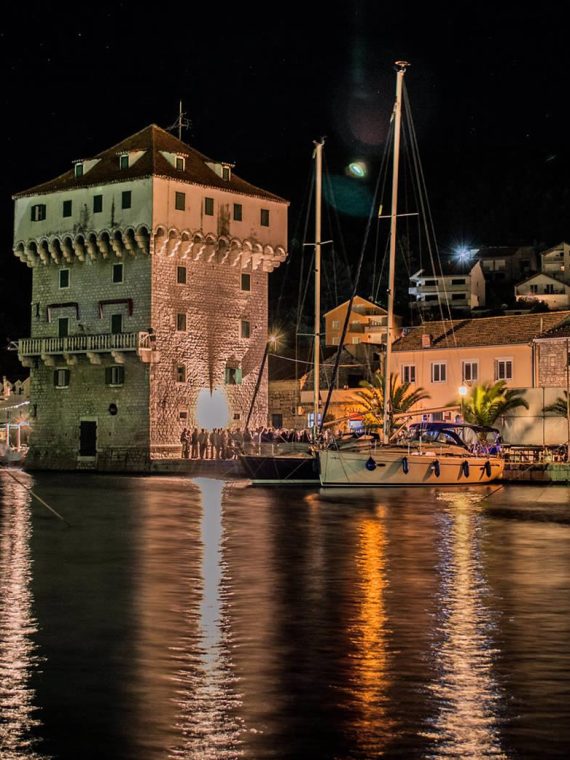
A perfect harmony of sun, sea, stone and man. Marina near Trogir is a village were you can relax the body and feed the soul… A combination of the ancient and the modern, old customs and tradition combine with the present way of living….
Here, you can experience more than an ordinary holiday: sail, dive, go fishing, drive with the boat or be a captain yourself on a boat or a yacht, which you can rent according to your wishes.
The nearness of the ancient town of Trogir (12 km) and Split (36 km) offers you the possibility of finding yourself in a few minutes in an unusual ambient of monuments of the highest category but also in the modern night- life of bars and discotheques..
If you enjoy the atmosphere of old Dalmatian taverns/ konobas, good fish and domestic brandy, you don’t have to go nowhere else apart from your holiday village.
The sandy beach of Marina, beside the clear sea and the shadow under old olive trees and pines offer you refreshment in the restaurant and the aperitiv-bar. -
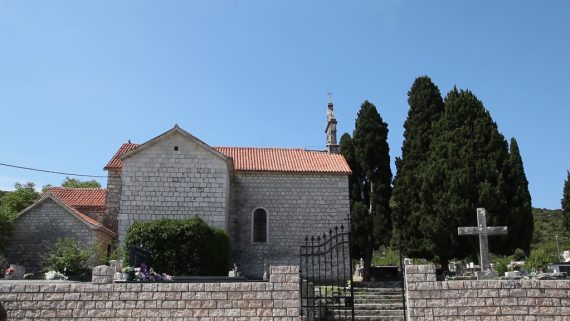
ST. JAMES’ CHURCH
The parochial church of St. James was built after the castle and citadel (Tower), in the shape of a Latin cross with two side-chapels. It was built in the 16th century, after the danger of Turkish invaders had passed. The church was originally built in the Renaissance style, and it functions both as a parish and a sepulchral church with gravesites. Today’s church interior is dominated by sumptuous baroque altars.

OUR LADY OF THE SNOW CHURCH ON DRID HILL
The original church was built in the 6th century and is 170 m above sea level. This can be substantiated by the semicircular arch constructed above the doorway with a stone inscription dating back to that time period. It is identical to the arched inscription in the Diocletian’s Palace in the heart of Split, with a missing section from the frontal display. A coat of arms was later carved into the mantle during the 15th century.
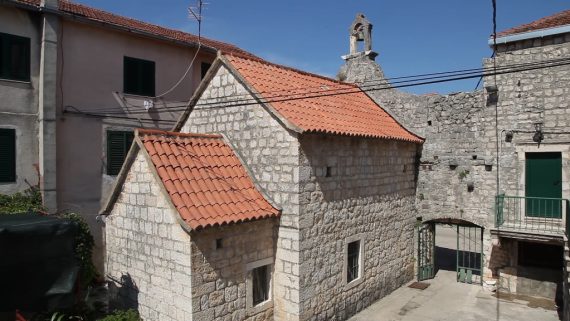
ST. JOHN THE BAPTIST CHURCH IN MARINA
St. John the Baptist Church is located in close vicinity to the castle, at the Stjepan Radić Square in Marina. It was probably built at the same time as the castle and the „“citadel“ – or defense wall – in 1495 or a bit later. Built in the Gothic-Renaissance style, a clock was later added to the church’s facade, blending in well with the architecture of the surrounding buildings. A large stone baptistery is located inside the church within a concave niche and a stone arch, on the right hand side of the entrance.

ST. MARINA CHURCH
This church is located on manicured park ground on the road to Trogir. Its roughcast exterior shows appearance, a round window above the doorpost and a small rock with a single bell. According to records dating back to the 18th century, the church had an outer baptistery, and was surrounded by monumental medieval tombstones called “stećci” which were used to adorn gravesites from the 14th to 16th century. Glagolitic monks were its caretakers. Paved in the 17th century, its interior is graced by the works of Master Cavalieri.

ST. LUKE’S CHURCH – POLJICA
St. Luke’s Church is in the village of Poljica. The village was initially known as Rastinić, first mentioned in the first half of the 13th century, in a trust deed. The heirs of a certain Vitača were donating land for St. Dominus and St. Nicholas’s monastery. Unfortunately, the exact year of construction is unknown. Above the door lies a carved stone plate inscribed with the coat of arms of the Sobota family from Trogir. St Luke’s has a massive stone altar in its apse. Although it was renovated in 1996, underlying Gothic features originating from the 13th or 14th century, are still plainly visible.

THE TOWER OF MARINA
The Tower of Marina is one of the town’s most distinctive landmarks. It was built by the Venetians as a defensive tower in case of land or sea invasion during the 15th century. It was later enlarged with a castle and city walls surrounding the entire settlement to protect its inhabitants from the encroaching Turkish army. For a period of time, the Tower of Marina was used by Bishop Franjo Marcello as a summertime villa. It has been recently converted into a four-star hotel. Today it is undoubtedly the brightest jewel in the crown of Marina’s cultural heritage site offerings.
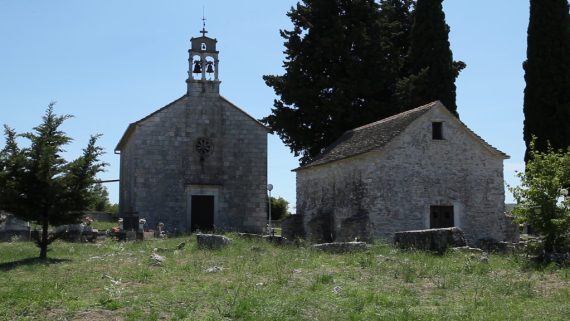
ST. MARY’S CHURCH – BLIZNA
This church was built in the 9th century. It is surrounded by a cemetery with “stećci”, or monumental medieval tombstones, as well as old headstones from an earlier time. An Early Croatian necropolis was discovered on the premises in 2000.
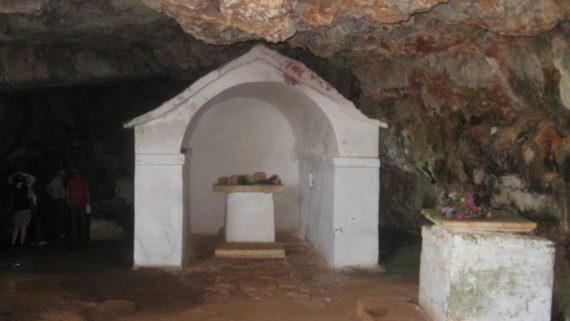
ST. PHILIP AND JAMES CAVE (DOLAC – MARINA)
West of the Drid Hill, 2 km away from the Marina parish church and in the middle of the Pliće slope (210 m) the St. James’ cave. Its dimensions are 60 m deep and 10 m wide. It is located near the unexplored ruins of the ancient town of Bausione, the foundation of the Marina settlement.
OUR LADY OF THE ANGELS CHURCH (POZORAC)
Pozorac is one of the oldest villages in the hilly exterior, with a medieval church of Our Lady of the Angels built with an accompanying graveyard. It was completely renovated in 1789, as evidenced on the church doorpost. Due to recent modifications, this church has been restored to its original condition and preserved from certain ruin. Holy mass is celebrated on August 2, the feast day of Our Lady of the Angels as well as the commemoration of General Andrija Matijaš Pauk’s death.
ST. GEORGE’S CHURCH (SVINCA)
The Marina hinterland is a very fertile agricultural area and was the reason behind many major feudal battles. Here is a small medieval church and adjacent graveyard on a hill within the village of Svinca. During the 18th century, it was dedicated to St. Catherine, but later St. George became its patron saint.
CHURCH OF ST. JOSEPH ON GORAČ (VRSINE)
The bishop of Šibenik Josip Arnerić made an agreement with then-pastor don Nikola Dragičević to buy a plot land at Gorač to build a church. The church was then dedicated to St. Joseph.
Due to the inherent danger of collapsing, pastor Dragičević and the two congregations of Vrsine and Poljica began a thorough and speedy renewal of the church and its surrounding area. With a spirit of determination and unity, he church’s renovations were mainly financed through the contributions of the congregation and volunteered work force by the residents of both Poljica and Vrsine.
The overall construction lasted for several months and on July 25, 2011 a rechristening ceremony of the newly renovated church was held, which came to be known as the “Dove of Gorač“.
REMNANTS OF ST. PETER’S CHURCH IN POLJICA
According to an orally transmitted legend, a tower in Poljica sank into the sea, and its stone dyke remaining visible to this day. This popular spot is known as Muline. Another legend claims that five nuns from St. Nicholas’s monastery (formerly St. Domnius’s) jumped into the sea while fleeing the Turks. They jumped from a cliff at the eastern section of the Poljica Bay, still known as Koludraški Krug or Koludrovac. Allegedly only one – Jela – survived, because she knew how to swim, and managing to reach the opposite shore. (Source: “Vinišćarski Zbornik III“)
ST. VITUS’S CHURCH IN SEVID
St. Vitus’s Church is situated on southern slopes of Sevid and is dedicated to St. Vitus, which is how Sevid got its name. The village is first mentioned in the 13th century, Some church originated ruins may be found on the site, and it is believed that the neighboring fences were also made from church stone. The renewal of St. Vitus’s Church is an ongoing restoration project.
CHAPELS AND SHRINES IN MARINA’S PARISH
St. Anthony’s Chapel in Gustirna
St. John the Apostle Chapel in Gustirna
St. Joseph’s Chapel in Najevi
St. Domenica’s Chapel on Krivotna
St. John the Baptist Chapel on Vrsine
St. Lucy’s Chapel in Najevi
Our Lady of Good Health Chapel in Gustirna
Sacred Heart of Jesus Church -
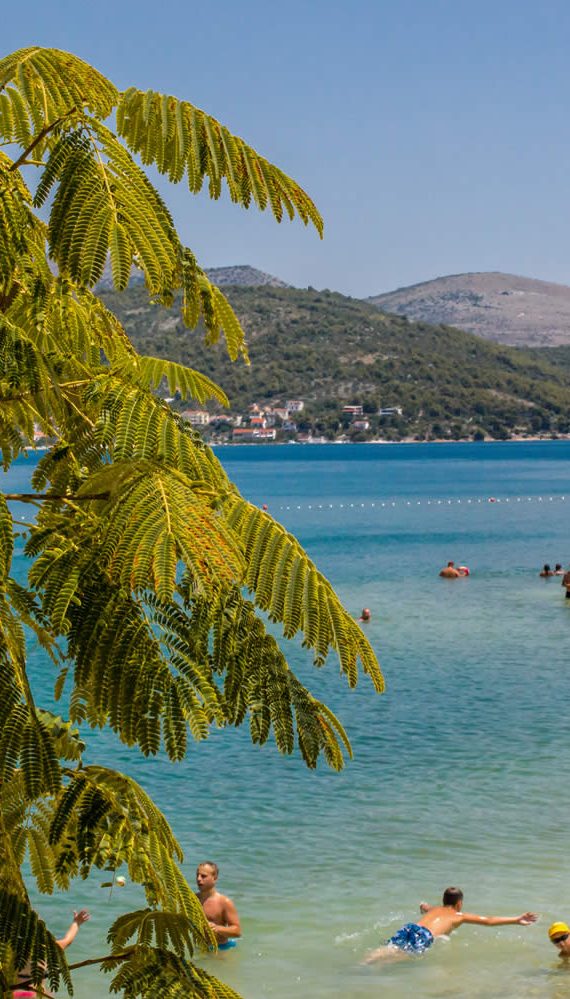
Stari (“Old”) Trogir Cove – Sevid – a culturally protected archeological site, is one of the most well-known sandy coves in the area. The remains of a large, luxurious maritime villa which remains partially hidden beneath the sea’s surface.
“Jama na Valjalo” – Najevi – is a natural dry well located in the village of Najevi, upon Valjalo hill. At 370 m above sea level, its interior is adorned with flowers, trees and corals. Speleologists believe that the pit is 90 m deep, perhaps even deeper.
Gomila Cave near Blizna Donja village – This secret cave has a remarkable depth of 30 m, an impressive 220 m2 hall, and beautifully adorned with layers of icicles and sparkling stalactites and stalagmites, a sight rarely seen even by speleologists.
First asphalt mine Minera – Here, at the Minera asphalt mine in Opatija, asphalt was first mined during the 19th century under the supervision of engineer Gustav Herman. Situated under Boraševica Hill on a slope north of Vinišće, the business was conducted and financed by the Rothschild Company from Vienna. Herman was succeeded by Henrico Hurting as the foreman in charge of the works. The finished product was then exported to Venice and Germany by “trabakuls“ (luggers), as well as for construction uses within Croatia. The site’s administrative building was built in 1835 at the foot of Boraševica Hill, with surrounding steam-powered auxiliary buildings and grinding mills for converting the mineral into a fine powdery base.
Villa Rustica at Japlena Gomila site – The ancient Villa Rustica (Roman Villa for retired military personnel) can be seen at the Japlena Gomila site. Situated in the Na Podan Dragoševac area, it is located on the north shore of the Vinišće Bay, at the great plain’s southeastern rim. A Communal Home was built after the Second World War, rearranging the layers with archaeological remnants of ancient building remains. During construction projects, ancient walls and ancient ceramics were continually discovered and unearthed. It is assumed that a Roman pier existed on the Japlena Gomila site next to the Villa rustica. Its existence, exact location and size will be confirmed with future underwater archaeological explorations.
-

Dalmatian cuisine is characterised by the use of natural products which, when properly combined and prepared, make for delicious and very special dishes. It could be said that the Dalmatian food is based on three essential pillars – olive oil, vegetables and fruit. Indeed, these three pillars have provided the sustenance of the Dalmatians peoples for more than five thousand years.The humidity from the sea, the long hours of sunshine, the mild weather and the fertile lands produce a rich and varied harvest. Dalmatian gastronomy is made up of dishes that are popular around the world. Dalmatian cuisine just wouldn’t be the same without basic ingredients such as olive oil – the undisputed king of Mediterranean cuisine.
Yet more than anything else, what really sets dalmatian cuisine apart from the rest is the culture and customs that surround and define it: meals are shared with family and friends; the dishes are tasty, prepared with loving care.When the holidays arrive you’re trying to forget a fast living rhythm which includes too much coffee and a whole bunch of sandwiches. In order to succeed in that, you should do everything the other way round. This includes: a slower daily rhythm, more time for relaxing and, among all the other things, also having the most delicious dishes that one can imagine. Marina can offer you all these things! If you asked local people which one is the most “famous” product from Marina, the answer would be for sure – olive oil and dry figs. The best record of our place that you can carry with you is “a liter of olive oil and a box of dry figs”. In our restaurants and taverns you can choose among a vast variety of dishes prepared in different ways. Fish, crabs, shells, pork, lamb, poultry, vegetables are grilled, roasted and prepared in different traditional manners… Delicious dishes are prepared in the same, authentic way in which, as archeological discoveries can confirm, our descendants used to make them more than 8000 years ago.
Most of the gastronomic facilities are situated in the center of the place, while in the broader municipal territory of Marina there are several rustic households where, within the authentic Dalmatian surrounding, you can enjoy traditional cuisine, homemade wine and other things.
-
We hope that the newly constructed recreational trails will contribute to the development of Marina as a sports and recreation destination. Due to the fact that we make part of the Cycle- Croatia program, our trails are linked to the trails of the municipalities of Primošten and Rogoznica and we hope that they will be recognized by a large number of foreign and local cycling clubs, travel agencies or alliances and that their activities will be focused towards this area.
Whether you’re an amateur or a professional you will certainly enjoy cycling through the woods or by the sea. This might be the best way to experience this environment, to buy a homemade wine or olive oil and to relax under the shadow of a pine tree on a secluded beach. By riding along these trails you will get the opportunity to enjoy the untouched nature and the hospitality of the local people. Each trail is enriched with a gastronomical offer throughout which you can taste the local cuisine and spend a night in a private accommodation. It has been created properly for you!
In the attachment you can download the map of the cycling trails in the municipality of Marina.
-

In 1657, the Great Turkish Army, led by Seidi Ahmet-pasha, went to conquer one of the most populous and richest towns in Dalmatia – Marina.
The attack began in late June, and the locals and captain Jakov Jerković did not agree to the surrender and defended themselves with all available weapons. The unexpectedly strong defense by aggressive defenders took the much larger Turkish army by surprise and forced the pasha to spend multiple days on destroying the town with big cannons. The Venetian Military Command did not send any assistance, believing that it was impossible to defend Marina, but the locals, with the help of about 30 people from the Island of Drvenik, wanted to defend their town at all cost and did not want to abandon it.
After seven days of resistance, the Turks began their final assault and the defending army, no longer able to stop the breaches through the broken walls, was almost completely destroyed, together with captain Jerković, whose heart was impaled on a spear. Approximately three hundred Marina inhabitants were killed, and nearly three hundred were enslaved, while, during the night and under fire, almost as many women and children sailed to the town of Trogir and its surrounding area. The Turks sacked and took valuable plunder – one thousand and two hundred horses.
The most interesting thing about the defense of Marina from the Turks in 1657 was that about 30 armed young women dressed in men’s uniforms actively participated in the fight. Two young widows, Kate Despotova and Matuša Škriljina, are best known for being captured at the end of the battle, and the Turks were so surprised to discover that they were fighting against women, that they did not kill them out of respect.
The third brave woman, a girl called Jele Marunova, who did not want to surrender, ignited several gunpowder barrels in the tower where women and children took shelter, killing a large number of enemies as well.
Thus Marina, a place where there had been up to forty births a year, was almost completely ruined. After 1657, many surnames never appear again in Marina and disappear completely, while some descendants of surviving old families still live on the territory of Marina, bound to their homeland even today.
PLACES NEAR MARINA

POLJICA
Poljica, a new tourist destination, grew up in the proximity of the chapel of St. Luke, who is patron of the place. Special ture of this place development of modern tourist apartments and rooms. Accomodation and excellent service guarantee the necessary comfort. So your holiday and pleasure would not be reduced at any time. Place has shops and catering facilities and there is, for receation, newly constructed football playground. There is the church of St. Luke, the patron of the place, built in 13th/ 14th century and remains . There are also the remains of the St. Peter’s church in Sumpetar cove. Place has shops and catering facilities and newly built recreation football field. There is the church of St. Luke, patron of the place, built in 13th/14th century, and the remains of the church of St. Peter in Sumpetar cove.

SEVID
Sevid is an ideal place for a quiet holiday away from the city noise and large tourist centers. Accommodation in Sevid can be found in one of the luxury villas, holiday homes or in one of the many apartments and there you can enjoy the untouched nature and crystal clear sea. On the southern slopes of Sevid, in the area Krč, there are archaeological remains of the Church of St. Vitus, after who Sevid was named. In Sevid you can enjoy the crystal clear sea on one of the many beaches and hidden coves that are found throughout the peninsula.
One of the most beautiful coves is Stari Trogir (Old Trogir), which is also an archaeological park, adorned with sandy beaches, clear water and the remains of a Roman villa. The buildings of the complex were built on the cliffs which provides further into the sea and land towards the vineyards. The northwest-southeast orientation of the complex was determined by the configuration of the terrain. The height of the walls throughout the complex varies from 1 to 3 meters. The walls were built of rough-hewn stone, and have an irregular structure and connected with solid limestone and waterproof plaster. This archaeological site was not researched, and it is not possible to determine its purpose with certainty.
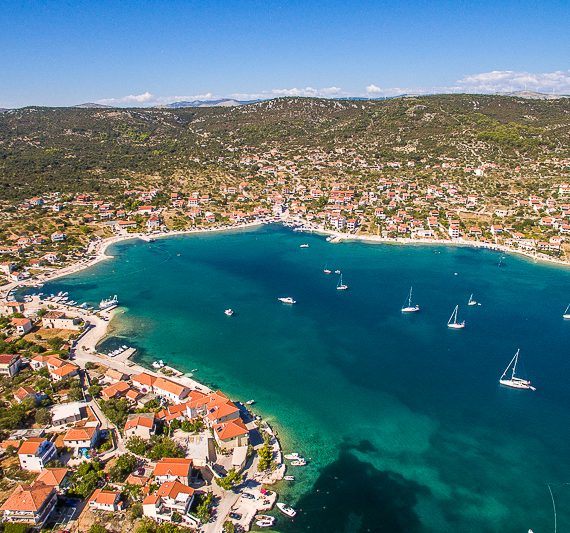
VINIŠĆE
Vinišće, a small fishing village only 8 km away from Marina, provides a unique feeling of tranquility and peace. The place is located in a beautiful quiet bay with crystal clear sea water and untouched nature, and is ideal for lovers of quiet family vacations in private rooms, villas, apartments and holiday homes. Visitors who seek adventure but also cherish their privacy will enjoy exploring one of the many hidden coves, such as Voluja, Ljubljeva and Ričevo Vrelo. The exact time of the origin of the settlement remains unknown, but the name Vinišće was first mentioned in documents of Trogir canon from 1272. The cultivation of grapes in Vinišće dates back to Roman times, so the name of the place is derived from the vineyard (Vinišća, old Croatian word for vineyards). Vines were planted by former Roman soldiers in places with were favourable conditions, and Vinišće, with its protected bay and fertile soil was ideal for cultivation. During the Middle Ages the territory was divided into the Diocese, the lower coastal part, and Opatija (the Abbey) – the upper continental part. From the 9th to the 12th century in the Vinišće area monasteries and churches were built, and the ruins are still visible.
The town has several beautiful churches. Church of the Blessed Virgin Mary (St. George) in Orihovica was founded by Benedictine monks in 1272. It is surrounded by an old cemetery with stone tombstones, the so-called “stećci”. Church of St. Anthony of Padua (Our Lady of Mount Carmel) was built in the 18th ct. in Vinišće itself. The new parish church of Sacred Heart holds a picture by an unknown painter from the 19th ccentury. The church of St. Joh, situated on the cape Ploča, was built in 1332. According to the legend, it was built on the exact spot where Blessed John of Trogir miraculously saved castaways from Šibenik whose ship had sunk. The famous Renaissance sculptor Ivan Duknović was born in Vinišće around 1440. His house was near the quarry Voluja from which he took the stone for the Trogir cathedral. He created statues in Rome, Venice and elsewhere. His stone relief “Madonna with a Child” is placed today above the tomb of Pope John Paul II.
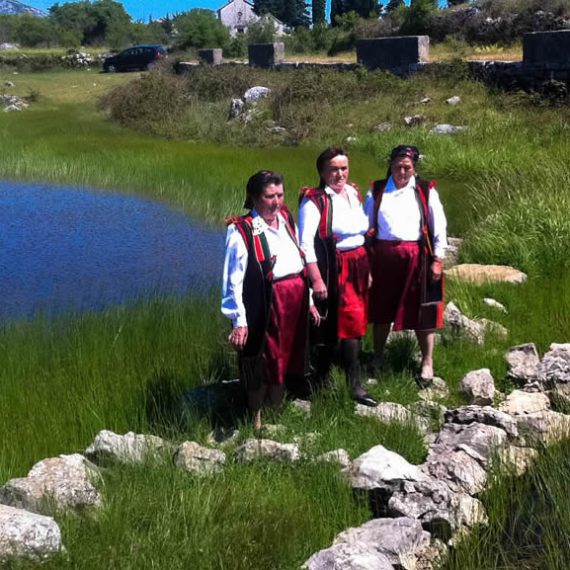
MARINSKA ZAGORA
If you go for a few kilometres further inland you will experience the authentic atmosphere. This exceptionally well-perserved area is rich in many archaeological sites. This is an area in which are preserved the orginal Dalmatian traditions and culture with its customs, costumes and local gastronomy. Almost untouched nature and numerous well preserved traditional villages with the orginal stone houses stand out. Village Blizna (Blysa), situated between villages Bristavice and Mitla, at the foot of the mountain Vialja on the territory of the medieval Drid county, was first metioned in 1251. It was long claimed by both Šibenik and Trogir. St. Mary’s Church from 9th century, which was mentioned in Trogir’s documets in 1300 , is situated out of village.
Around the church is a cemetery with medieval tombstones – “stećci“, and old gravestones, and an Early Croatian necropolis was discovered in 2000. The cemetery belonging to the village Blizna Gornja is an archaeological site in a karstic field on the very border between Trogir and Šibenik, on a location abundant in spring water and with a puddle which never peters during summer draughts.


